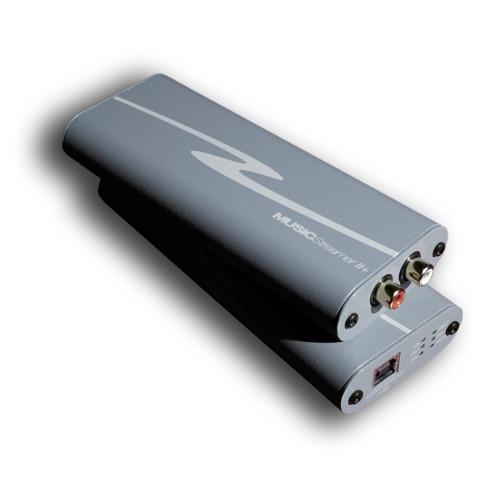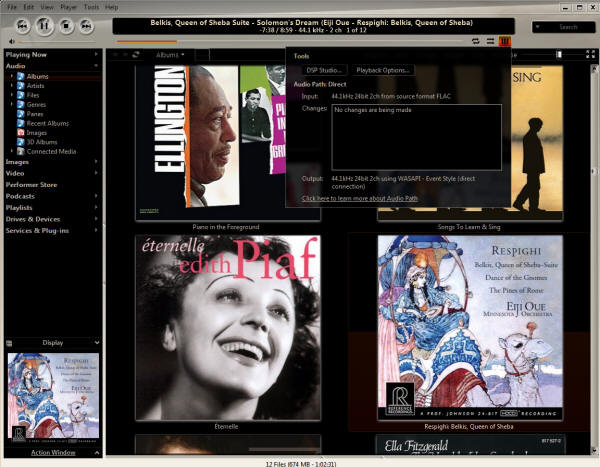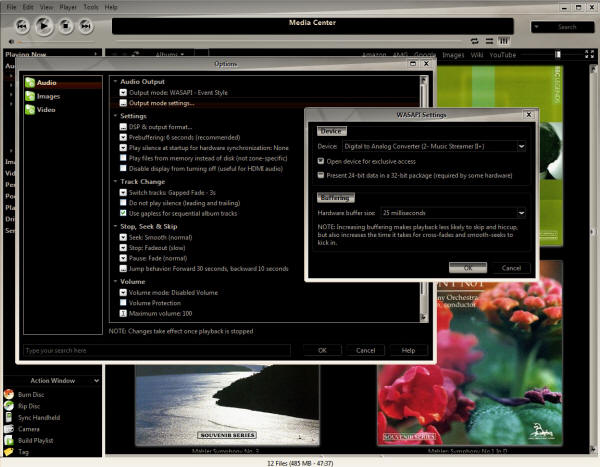|
You are reading the older HTML site
Positive Feedback ISSUE 65
Taking Another Look at the High Resolution
Technologies
Music Streamer II+
Recently I was contacted by fellow PFO'er Steve Lefkowicz, who had some questions about my implementation of the Music Streamer DAC with JRiver Media Center. Steve and I share a very similar approach to high-end audio; we both are attempting to get the best sound possible from relatively affordable yet audiophile-quality equipment. Steve was having some difficulty getting his Music Streamer to work properly with JRiver Media Center, and I'd basically gone through the same circumstances when I'd started using JRiver full-time midway through this past year. I've had the MS II+ in the system for about two years now, and I've also had the pleasure of using the Centrance DACport LX and the Audioquest Dragonfly (currently in the review process) over the last six months as well. At the point midyear when I made the switch from Foobar 2000 to JRMC, I was pretty much using the Centrance unit full-time. Mainly because I was still pretty enamored with its amazingly good plug-and-play sound, but also because of the level of difficulty I was having getting the HRT unit to function well with the JRiver software program. The main problem boiled down to the following conundrum: I couldn't get files of differing bit rates to play seamlessly using Media Center through the Music Streamer II+ using WASAPI Event Style. I could get either 16-bit files or 24-bit files to playback essentially without problems, but never in combination and on-the-fly without the unbearable stuttering artifacts we're all so familiar with. I've done all the firmware updates to the MS II+ unit, and had numerous email exchanges with JRiver, but nothing that would reconcile the situation or get me any closer to improved playback. I finally ended up downloading the ASIO4ALL software and after increasing all the buffers to the maximum, I was finally able to get playback of mixed bitrate files using the MS II+. Although I wasn't absolutely convinced that the sound quality was as transparent as what I was getting otherwise, I was spending so much time with the amazingly good Centrance unit that the situation had become pretty much a non-issue. A Truly Serendipitous Discovery Not long before getting the email from Steve, I'd been playing about with the GUI settings of Media Center, and decided to change the display skin to “Noire”, which offers one feature that's very interesting and different from all the others. All skins in Media Center offer a variety of buttons that control a boatload of functions, but one button in particular, the Audio Path button, opens a window that displays all input and output bitrate information. If the audio signal is direct, and therefore, bit-perfect, the Audio Path button glows blue if you're using the Noire skin. Or in my case, I have the Noire skin set to its inverse position (black background), and the Audio Path button glows orange instead. So if the Audio Path button isn't illuminated—you're not getting bit-perfect playback.
After reading Steve's email, I decided to take another listen to the MS II+, and low and behold, when I switched between DACs from the DACport LX to the MS II+, the Audio Path button didn't glow! With ASIO, I wasn't getting bit-perfect playback with the Music Streamer—I know I've touched on this quite a few times in the recent past, but dammit, how incredibly difficult a task it can be to get files to stream bit-perfectly using USB digital-to-analogue converters! And I've spent some time discussing the sound differences between these units as well, and I can't help but believe that some of the negative comments I've read in the blogosphere regarding the HRT units are quite possibly based on non-bit-perfect evaluation. And I also want to re-emphasize that of all the compact DACs I've evaluated thus far, the Music Streamer II+ is the only one that doesn't add any kind of noise whatsoever to the audio signal (at least in my system).
About the same time all this was going down, I was also reading a pretty informative thread on the Audio Asylum blog that had a number of really incisive comments from Charles Hansen of Ayre talking about the difficulty involved in implementing seamless changes between sources of varying bit rates. Fueled with this new information, I immediately started playing about with the JRiver Playback Option settings, decided What the Hell, I'd give WASAPI Event Style another shot, and under the Audio Output tab, spent the next two days painstakingly switching from one hardware buffer to another until finally settling on 25 milliseconds. I also disabled Memory Playback, and amazingly enough, suddenly the MS II+ started pouring out beautiful, unstuttering music—all this time, and based on my ASIO experience, I'd been trying to increase the buffer size with really poor results. All that was required was to decrease the buffer size significantly (a very counter-intuitive move), and I don't know why disabling Memory Playback made a difference, but it most definitely did. I won't lie—it doesn't work absolutely perfectly with on-the-fly changes between files of differing bit rates—with some files, you have to completely stop whatever's playing, then start the new file, but they do play without any stuttering artifacts at all. Of course, this is strictly USB, so it's limited to 16 bit/44.1 and 24 bit/44.1/96 files, but hey—it works! Re-Evaluating the Sound of the Music Streamer MS II+ Using ASIO4ALL had become my only functional workaround for the Music Streamer II+, but with three DACs in the system at the same time, it was getting very little use, not nearly enough for me to critically evaluate what was going on in comparison to the other two DACS. I now realize, the MS II+ was playing non-bit-perfect, and the sound with ASIO was darker and more veiled. With WASAPI Event Style, sound through the Music Streamer II+ is impressively transparent and musical, with deep, robust bass and clear, crisp extended treble response with superb ambience retrieval. Now, granted, I'm kind of the “low budget” guy around here, and I haven't had the luxury of reviewing any recent DACs that are priced any higher than around $400. But I do listen to a lot of LPs, and a previous system incarnation from years past included a $1500 Theta DAC with an $800 Pioneer Elite transport. The sound I'm getting from the MS II+ equals or surpasses LP sound in virtually all instances, and easily surpasses the sound from the Theta/Pioneer digital front end. Any differences at all that I thought I heard in comparison with the Audioquest and Centrance units have been either equalized or minimized by this setup, and I've been A/B/C'ing between these units almost ceaselessly for a couple of months now. Whereas the MS II+ was almost an afterthought with me, now, in combination with the associated lack of any additional input noise from the Music Streamer, it now definitely is my preferred playback device in the under-$500 range. Yes, the Audioquest and Centrance units are truly plug-and-play, and require a minimum of setup to obtain great sound (why can't they all be this easy?). For the average user, I can't begin to express how incredibly advantageous getting bit-perfect sound right out of the box is. But even with the additional work required to get the HRT unit playing bit-perfectly, I still have to give it the overall nod in transparency and musicality. In Conclusion Hey, in my last article, I mentioned that I'm now using dBpoweramp for all my ripping, and it includes a plug-in that allows you to rip HDCDs at full 24-bit resolution. I've been slowly ripping all my CDs to lossless FLACs, and finally got around recently to ripping the Reference Recordings CDs in the rack. All I can say is WOW! One disc in particular, Resphigi's Belkis, Queen of Sheba offers maybe the best orchestral sound I've ever experienced, bar none. The soundstage is impressively wide and deep, seeming to expand way beyond the loudspeaker position, and the orchestral climaxes are nothing short of breathtaking. I'm currently using the outstanding Zu Audio Omens in the system (review is forthcoming on these babies as well!) which deliver everything from Metallica to Resphigi with heart-pounding precision, and this bit from Reference Recording is definitely my new system demo piece. I've gotten a few emails recently that have perhaps called my approach and conclusions during this journey into question. From what I see on the internet, there are a whole lot of people with a whole lot of questions about computer audio, and I really doubt that the majority of them can rush out and impulse purchase an Ayre, Benchmark or Wavelength USB DAC. Earlier I mentioned that I've yet to audition any USB DAC more expensive than $400 in my system, so I truly can't say what I might be missing with better equipment. What I can say definitively is, with a little work, there's a whole lot out there in the sub $500 range that offer incredibly good sound. But in my opinion, none of them can touch the accuracy and musicality of the Music Streamer II+; any complements I've heaped on the MS II+ in the past, times that by ten. With sound this good, I honestly couldn't want for anything else. These are heady times for music lovers, and just about anyone can follow their impulses and press the buy button for a mere $349.
High
Resolution Technologies
|



